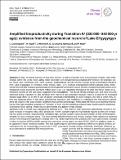Files in this item
Amplified bioproductivity during Transition IV (332 000-342 000 yr ago) : evidence from the geochemical record of Lake El'gygytgyn
Item metadata
| dc.contributor.author | Cunningham, L. | |
| dc.contributor.author | Vogel, H. | |
| dc.contributor.author | Wennrich, V. | |
| dc.contributor.author | Juschus, O. | |
| dc.contributor.author | Nowaczyk, N. | |
| dc.contributor.author | Rosen, P. | |
| dc.date.accessioned | 2014-07-22T09:31:07Z | |
| dc.date.available | 2014-07-22T09:31:07Z | |
| dc.date.issued | 2013-03-14 | |
| dc.identifier | 134406215 | |
| dc.identifier | e9b037b1-6d21-4da5-bcdc-93993dbbaaf7 | |
| dc.identifier | 000317009700011 | |
| dc.identifier | 84881130929 | |
| dc.identifier.citation | Cunningham , L , Vogel , H , Wennrich , V , Juschus , O , Nowaczyk , N & Rosen , P 2013 , ' Amplified bioproductivity during Transition IV (332 000-342 000 yr ago) : evidence from the geochemical record of Lake El'gygytgyn ' , Climate of the Past , vol. 9 , no. 2 , pp. 679-686 . https://doi.org/10.5194/cp-9-679-2013 | en |
| dc.identifier.issn | 1814-9324 | |
| dc.identifier.uri | https://hdl.handle.net/10023/5058 | |
| dc.description | Funding was provided by the German Federal Ministry for Education and Research (BMBF; grant no. 03G0586A, B), the German Research Foundation (DFG, JU 465/2-1), FORMAS and Vetenskapsradet. This research was also supported by the Climate Impacts Research Centre (Umea University) who provided salary to Laura Cunningham and Peter Rosen. | en |
| dc.description.abstract | To date, terrestrial archives of long-term climatic change within the Arctic have widely been restricted to ice cores from Greenland and, more recently, sediments from Lake El'gygytgyn in northeast Arctic Russia. Sediments from this lake contain a paleoclimate record of glacial-interglacial cycles during the last three million years. Low-resolution studies at this lake have suggested that changes observed during Transition IV (the transition from marine isotope stage (MIS) 10 to MIS 9) are of greater amplitude than any observed since. In this study, geochemical parameters are used to infer past climatic conditions thus providing the first high-resolution analyses of Transition IV from a terrestrial Arctic setting. These results demonstrate that a significant shift in climate was subsequently followed by a rapid increase in biogenic silica (BSi) production. Following this sharp increase, bioproductivity remained high, but variable, for over a thousand years. This study reveals differences in the timing and magnitude of change within the ratio of silica to titanium (Si/Ti) and BSi records that would not be apparent in lower resolution studies. This has significant implications for the increasingly common use of Si/Ti data as an alternative to traditional BSi measurements. | |
| dc.format.extent | 8 | |
| dc.format.extent | 1806103 | |
| dc.language.iso | eng | |
| dc.relation.ispartof | Climate of the Past | en |
| dc.subject | Transform infrared-spectroscopy | en |
| dc.subject | Climate variability | en |
| dc.subject | Crater lake | en |
| dc.subject | Organic-matter | en |
| dc.subject | North-Atlantic | en |
| dc.subject | Core PG1351 | en |
| dc.subject | NE Russia | en |
| dc.subject | Ice-core | en |
| dc.subject | Siberia | en |
| dc.subject | Sediments | en |
| dc.subject | G Geography (General) | en |
| dc.subject | SDG 13 - Climate Action | en |
| dc.subject.lcc | G1 | en |
| dc.title | Amplified bioproductivity during Transition IV (332 000-342 000 yr ago) : evidence from the geochemical record of Lake El'gygytgyn | en |
| dc.type | Journal article | en |
| dc.contributor.institution | University of St Andrews. School of Geography and Geosciences | en |
| dc.contributor.institution | University of St Andrews. School of Earth & Environmental Sciences | en |
| dc.identifier.doi | 10.5194/cp-9-679-2013 | |
| dc.description.status | Peer reviewed | en |
| dc.identifier.url | http://www.clim-past.net/9/679/2013/ | en |
This item appears in the following Collection(s)
Items in the St Andrews Research Repository are protected by copyright, with all rights reserved, unless otherwise indicated.

